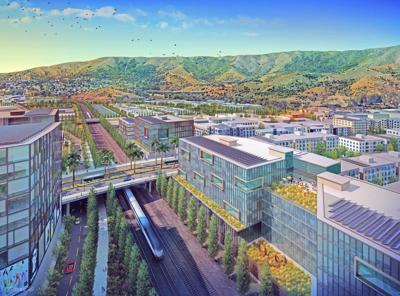Brisbane officials released a new economic study analyzing the project proposed to transform the Baylands, balancing the potential financial strain posed by residential growth against opportunities presented through commercial development.
Members of the Brisbane City Council are expected to review the report from consulting firm Keyser and Marston Associates during an upcoming meeting Thursday, March 22.
Analyzing developments ranging in size between 1,000 and 2,200 housing units with 2 million to 6 million square feet of commercial space, the report lays out scenarios for offsetting the assumed fiscal impact tied to building new homes.
As councilmembers consider the findings, they should work toward assuring any development potentially approved for the highly-watched site is a revenue generator for the city.
“Staff recommends that any development of the Baylands provide net revenues to the city sufficient to produce a reasonable financial surplus annually against unanticipated costs or risks that may arise in connection with a development,” City Manager Clay Holstine said in a memo to the City Council.
He added their considerations should also span other issues associated with the sweeping proposal, such as the substantial environmental remediation required to make the site suitable for development and the battle for local control through the approval process.
In an attempt to exercise their authority, officials approved in January reviewing projects significantly smaller than the initial proposal brought by Universal Paragon Corporation, which offered 4,400 units and 7 million square feet of commercial space.
Brisbane officials and community members have scrambled to preserve their jurisdiction over the matter, amidst growing pressure from housing advocates and legislators to approve new homes at the site.
Proponents claim the Baylands’ proximity to rail lines connecting the Peninsula makes it a prime spot for transit-oriented development, while critics say widespread soil contamination lessens the project’s appeal.
Emotions on both sides ramped up in recent months, in the wake of new laws passing designed to sap the power of local officials rejecting housing development near transit centers.
Perhaps most offensive to Brisbane residents was discussion of a draft bill seeking to mandate housing development at the Baylands. Though the legislation was not formally proposed last year, locals fear the effort may be resurrected if some residential development at the site is not approved.
Recommended for you
With heightened awareness of the attention paid to the project, Brisbane officials have worked to develop a vision they consider more palatable than the sweeping offer initially proposed.
The downsized projects examined in the fiscal impact report reflect that effort, as the largest residential component is roughly half the size of the developer’s first offer.
Even with thousands fewer housing units, the report finds a sizable amount of commercial space must be included to limit the city’s expected financial burden.
With only 2 million square feet of commercial space, the city can project losing between $400,000 annually through the development of 1,000 units and the financial drain jumps to about $1 million per year with 2,200 units, according to the report.
Alternatively, the city could expect to receive as much as $2 million annually with 6 million square feet of commercial space and 1,000 housing units. The largest studied development — 2,200 units and 6 million square feet of commercial space — would generate about $1.46 million, according to the report, which also studies a variety of alternatives.
Considering the myriad options before councilmembers, Holstine encouraged officials to view the potentially transformative proposal through a wide lens.
“Staff further recommends the City Council deliberate on the implications of the fiscal analysis balanced against the concerns identified at previous City Council meetings on the Baylands as being at issue with the proposed development, including the need for extensive environmental remediation of the site and the desire to preserve local control over development decisions in the face of the state Legislature adopting policies limiting local control,” he said.
The Brisbane City Council meets 8 p.m. Thursday, March 22, at City Hall, 50 Park Place.
(650) 344-5200 ext. 105
























(0) comments
Welcome to the discussion.
Log In
Keep the discussion civilized. Absolutely NO personal attacks or insults directed toward writers, nor others who make comments.
Keep it clean. Please avoid obscene, vulgar, lewd, racist or sexually-oriented language.
Don't threaten. Threats of harming another person will not be tolerated.
Be truthful. Don't knowingly lie about anyone or anything.
Be proactive. Use the 'Report' link on each comment to let us know of abusive posts.
PLEASE TURN OFF YOUR CAPS LOCK.
Anyone violating these rules will be issued a warning. After the warning, comment privileges can be revoked.